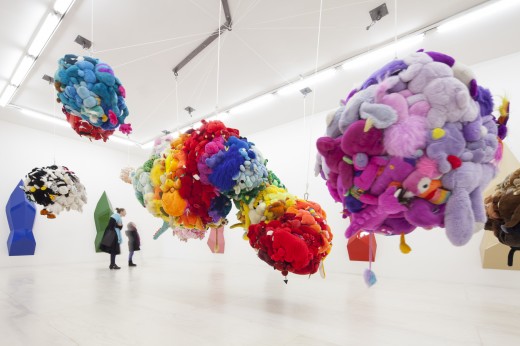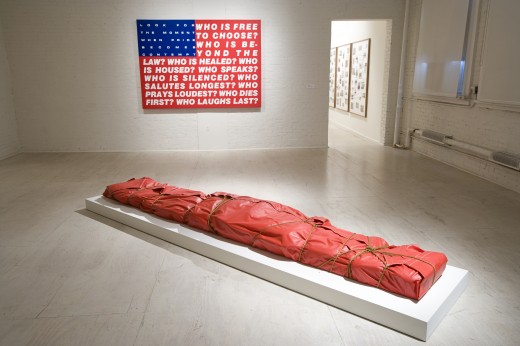Peter Eleey
René Morales

Installation view of Mike Kelley, at MoMA PS1, 2013. Photo: Matthew Septimus.
RENÉ MORALES (RAIL): Are there particular principles or themes or ideas that you wish to explore, or even express, through PS1’s exhibition program, over the long term? Is PS1, and New York, conducive to that way of thinking about a program, or does this context imply a different approach, a different timescale?
PETER ELEEY: Rather than set out a series of themes when we started, Klaus [Biesenbach] and I resolved to use the program as a way to explore different approaches in real time, and we have had the luxury to try out a number of models. We have continually tried to ask ourselves how to make the most of our building and location, and to consider the role PS1 can play both in the landscape of New York and in relation to MoMA.
Most recently, for example, we turned the whole building over to a retrospective of Mike Kelley, which is the largest solo show PS1 has ever hosted. No one else could have done that in New York. Contrast that to last year at this time, when we had a diverse mix that was also unique, combining new, old, under-known, experimental, and historical at various scales: a large introductory show of a young artist who had not yet shown much in New York (Cyprien Gaillard), a premiere mid-career survey of a local artist (Huma Bhabha), a full retrospective of an under-recognized influential New Yorker (Thomas Lanigan-Schmidt), the first US show of a major young voice (the Londoner Ed Atkins), a small overview of the work of conceptual designers Metahaven, an installation-cum-performance space by Confetti Systems, a group show of emerging artists that suggested some newer trends visible here and elsewhere (New Pictures of Common Objects), and an historical survey of African-American art and culture from Los Angeles during the period from 1960 to 1980. In general, we see fewer experimental group shows getting made in the US, including in New York. Noting PS1’s long history with such exhibitions, we have sought to continue working in that vein, organizing shows like September 11 and EXPO 1, each of which grappled with current events that touched New York (9/11 and Hurricane Sandy) but engage broader national and international issues.
We have also experimented with different kinds of performance programming, using galleries (as we will be doing with Xavier Le Roy in the fall), public spaces, and our courtyard. We bought a large off-the-shelf geodesic dome that we erect in our courtyard during the non-summer months to create a space that would push us to try new things, and program it every weekend. More recently, we have also started renting an old print shop next door, which has direct street access and allows us to program after hours in a very different context.
We also felt it was important to work on different time scales. Typically, we program larger spaces further in advance, but we keep a number of smaller galleries on shorter leads, so that we are forced to work more responsively and locally. We also sometimes keep certain shows up longer as anchors for other, quicker things in the building.
RAIL: Could you expand on the relationships that determine PS1’s program and institutional identity—its relationship with MoMA, with the New York art establishment, with New York-based artists, with the residents of Long Island City… What do these relationships look like in ideal form?

Installation view of Mike Kelley, at MoMA PS1, 2013. (Deodorized Central Mass with Satellites, 1991/1999) Photo: Matthew Septimus.
As to audience, we think about a core group that comes repeatedly and follows our program closely, which is a mix of artists and people who have professional links to the art world here and beyond the city. A large portion of our audience is based in north Brooklyn, rather than Long Island City per se, and it is important to us that we are a museum for the city, not the neighborhood specifically. That said, we have tried to think about amenities that the neighborhood lacks, and that also feel like things that make sense at MoMA PS1. We haven’t brought a grocery store to the museum, but we opened a magazine shop and gave a home to one of the best restaurants in the neighborhood after it closed—small but good things that improve the quality of life around here even if you don’t like art.
RAIL: What’s it like working with PS1’s unique space?
ELEEY: It’s easier, in some ways, because it is a found architecture. We build relatively few walls. I started as a curator working in disused spaces around New York, some similar to the way PS1 was when Alanna Heiss did the first show here, and I like having to work within those set conditions. I can then spend my time worrying about other things. Of course there are certain things we can’t show, or can’t fit, but that is no different than wanting things you can’t afford or that lenders might not make available to you—it’s just one more factor. Yet there is also a pleasure in building a show and its architecture concurrently, and finding the right form to move through the show. I’ve certainly enjoyed working that way, starting with an open room, and found its challenges really rewarding. In general, having worked in a range of spaces, I prefer those that have character, and problems to work with and push against.
RAIL: Some curators seem to try to downplay or avoid the technical nitty-gritty of installation, farming as much of it as possible out to the artists or the prep chiefs, exhibition designers and registrars; others really seem to love and revel in it, some even seem to fetishize it. Where do you see yourself on that spectrum?
ELEEY: I don’t fetishize production or installation, but I do enjoy being involved in it. I did production and logistics before I did curating, and my familiarity with those details certainly informs how I work. It is also important for me that I understand the realities of what I ask our team to undertake, it is important for me that they know I know—it means we respect each other, and work better together. When artists need complicated things to happen, I also like being able to assess the practicalities myself, and to take responsibility for them in the broader context of our relationship. I think that level of involvement makes me a better curator. And curating is, finally, a profession of making choices. I want to make those choices with as much information as possible.
RAIL: What are your thoughts on curatorial “style”? Are there particular stylistic tendencies that can be perceived out there in the field? What do the more current, up-to-date styles look like? How has your own approach changed and developed over the years?

Installation view of September 11, at MoMA PS1, 2011. Photo: Matthew Septimus.
RAIL: To what extent would you say your work is informed by research, particularly research into non-art fields and disciplines such as urbanism, architecture/design, critical or political theory, etc.?
ELEEY: I often find myself looking at art through life—a banal thing to say, I suppose. What I mean is that I find certain works resonate for me through their connection with things outside of their art contexts: subjects I’m reading and thinking about across a range of disciplines, and things I’m feeling. And art also leads me to those feelings independently, and suggests new subjects and things to think about. I get a lot of work done in bookstores, for example, even just in looking at how things are grouped on the shelves. It’s never a one-way street.










